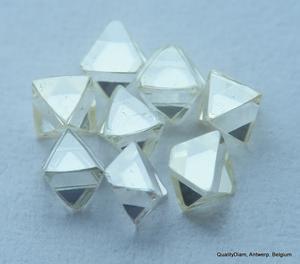Unveiling the Splendor of Natural Diamond Crystals: Nature's Masterpiece
Diamonds have captivated human fascination for centuries. Their brilliance, rarity, and enduring beauty make them the ultimate symbol of luxury and love. While most of us are familiar with the polished, faceted diamonds adorning jewelry, the journey of a diamond begins long before it reaches the jeweler's hands. Deep within the Earth's crust, natural diamond crystals form under intense pressure and heat, creating breathtaking marvels of nature.
Natural diamond crystals are born
from carbon atoms arranged in a unique crystal lattice structure. They are
formed deep within the Earth's mantle, typically at depths of 150 to 200
kilometers, where extreme heat and pressure transform carbon into the hardest
material known to man. Over millions, even billions, of years, these crystals
slowly make their way to the surface through volcanic eruptions, carried within
rocks known as kimberlites and lamproites.
Each natural
diamond crystal is a testament to the Earth's geological history,
bearing the scars of its journey to the surface. These crystals can vary
significantly in size, shape, and color, reflecting the diverse conditions
under which they formed. Some diamonds emerge as octahedrons, with eight
symmetrical faces, while others take on more complex shapes like cubes,
dodecahedrons, or even irregular forms. The color of a diamond is influenced by
impurities present during its formation, ranging from the purest white to vibrant
hues of yellow, blue, pink, and beyond.
One of the most remarkable
characteristics of natural diamond crystals is their internal structure, often
marked by inclusions and imperfections known as "nature's
fingerprints." These imperfections, such as minerals trapped within the
crystal lattice or tiny fractures, give each diamond its unique identity, like
a signature from the depths of the Earth. While some inclusions may detract
from a diamond's clarity, others enhance its beauty, creating mesmerizing patterns
known as "diamond birthmarks."
Beyond their aesthetic allure,
natural diamond crystals hold scientific significance, offering valuable
insights into the Earth's deep geological processes. By studying the
composition and structure of diamonds, geologists can unravel the mysteries of
our planet's formation and evolution over billions of years.
In conclusion, natural diamond
crystals are not merely exquisite gemstones but also windows into the Earth's
ancient past. Their formation is a testament to the forces of nature, shaping
these precious treasures over vast stretches of time. Whether admired in a
museum specimen or cherished in a piece of jewelry, each natural diamond
crystal is a marvel of nature's craftsmanship, reminding us of the Earth's enduring
beauty and complexity.




Comments
Post a Comment